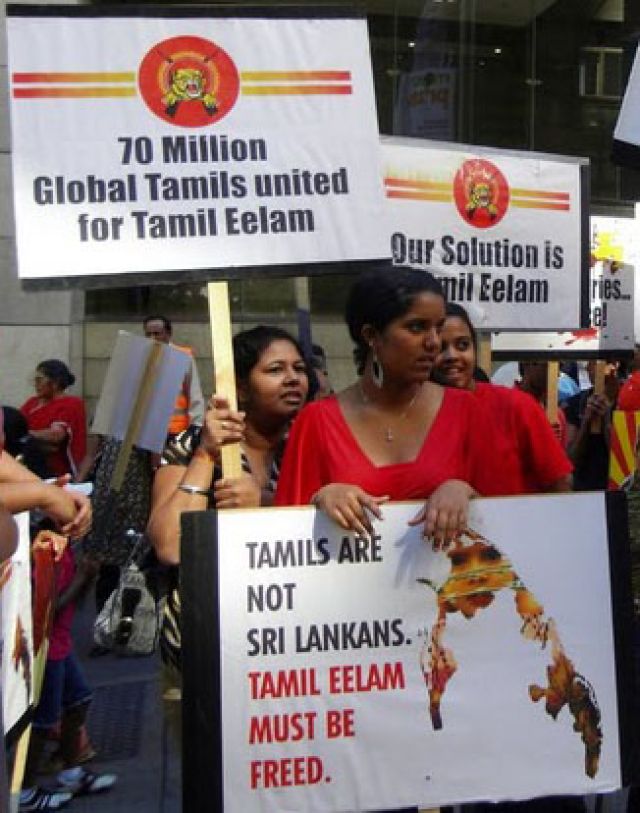
A May 17 International Crisis Group report said there were “reasonable grounds to believe the Sri Lankan security forces committed war crimes with top government and military leaders potentially responsible” in the last five months of the 30 year long war against Tamil independence fighters. The report cited the intentional shelling of civilians, hospitals and humanitarian operations.
It called for war crimes prosecutions and warned against countries deporting Tamil refugees to Sri Lanka. Australia currently has ceased processing asylum applications from Sri Lanka on the grounds that the country will soon be safe. In the article below Myuran Elango reflects the situation for Sri Lankan Tamils a year after the war ended.
On May 18, the paradox of reality crystallised in the island of Sri Lanka, rising above the fog of war to reveal two contrasting tales left behind in the aftermath.
For the island’s majority Sinhalese community, a week of victory festivities culminated in an orchestrated swelling of unity and national pride, as Sri Lankan President Mahinda Rajapakse celebrated one year since crushing the Tamil Tigers, which ended three decades of armed conflict.
For every victory party, there must be a losing side. Tamils across the world will travel down a very different path, one bathed by the shadows of sorrow and grief as they pay respects to an estimated 100,000 Tamil civilians killed in the bloodshed.
Almost 40,000 Tamils perished in the final days of the war, former United Nations spokesperson in Sri Lanka, Gordon Weiss, told the ABC’s Foreign Correspondent on February 9.
After being forsaken by the world for decades, their cries were met with a deafening silence. Anyone that survived the onslaught of war awoke to a world encaged in barbed wire and an international community singing the praises of their enslavers.
The outbreak of civil unrest that paralysed the island for almost half a century stemmed from the systemic oppression of the island’s minority Tamil community by successive administrations.
With the legitimate grievances of the island’s Tamils largely ignored, a groundswell of support calling for self determination emerged. This gave birth to the Liberation Tigers of Tamil Eelam (LTTE), who, for more than 30 years fought the Sri Lankan armed forces in their quest for an independent homeland in the Tamil-majority north and eastern provinces of the island.
Although the guns are silent, the government’s insistence that the nation is now a unified melting pot of ethnic and cultural harmony, standing under one flag and one identity, remains questionable.
Almost 90,000 Tamil internal refugees remain imprisoned in military camps, says the Internal Displacement Monitoring Centre (IDMC). This isn’t a surprise to anyone with an iota of knowledge regarding the Sri Lankan establishment’s approach to internal affairs.
A May 3 Amnesty International report said Sri Lanka is today one of the most dangerous countries in the world for journalists, who are fearful of the swift arm of sedition and censorship by a government adamant about hiding the reality behind victory.
This isn’t news to the families of dozens of news workers killed during the war.
International instruments of justice and democracy, the UN and the entire Western world have failed to decry the fact that an entire population languishes in incarceration based solely on their ethnicity and place of residence.
Neither have they diagnosed the symptoms of dictatorship such as bouts of media suppression. The lack of genuine interest in Sri Lanka’s deteriorating social fabric continues to mask the stench of its decline into the pits of totalitarianism.
For all the tragedy that indifference has bought upon the Tamil people of Sri Lanka, the policies of division, of “us” and “them”, that set the war machine in motion remain the most haunting.
To see the Australian government in recent months adopt this xenophobic mindset by rejecting asylum claims of Tamil nationals to stem the apparent “flood” of “boat people” only serves to illuminate the daunting reality faced by Sri Lanka’s victims of war:
Tamils are told: your incarceration is inevitable, be it as second-rate citizens at the hands of your vanquishers, or herded into offshore Australian detention facilities.
Tamil refugees become sacrificial lambs for Australian Prime Minister Kevin Rudd to appease the Gods with, in return for an electoral popularity boost.
The fighting formations of the Tamil Tigers may have been annihilated in the final days of the war. But the yearning for freedom and equality, which fostered a generation of militancy and fuelled its rise up the ladder of infamy, continues to consume Tamil hearts and minds.
When the Sri Lankan government chose to forego its opportunity for a dignified victory by enslaving the vanquished, it succeeded only in opening up a new war front.
For Tamils, May 18 was a day of reflection. The next generation of Tamils lit candles in remembrance, their silhouettes stretched across landscapes in a gentle reminder to the architects of their brethren’s demise that the rumblings of agitation and desire for freedom remains steadfast.